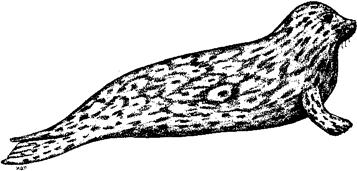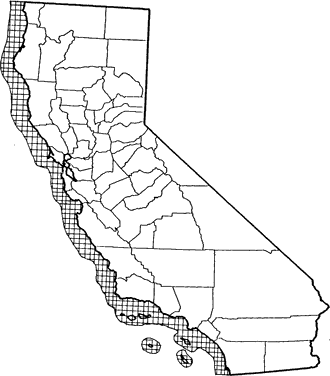
Harbor Seal
Distribution, Abundance, and Seasonality
Fairly common, non-migratory pinnipeds found on California islands and along entire mainland coast. Results of a June 1984 census of California mainland and islands indicated that an estimated 25,000 harbor seals inhabited California coastal waters. A 1981 estimate indicated 10,000 harbor seals (Bonnell and Pierson 1981). Rarely seen in pelagic waters west of Channel Islands, prefer to remain close to shore in subtidal and intertidal habitats. Often swim into bays and estuaries, and sometimes venture into rivers in northern California. Frequently haul out in small to moderate-sized groups on emergent offshore and tidal rocks, mudflats, sandbars, and sandy beaches (Orr 1972).

Range Map
Specific Habitat Requirements
Feeding: Forage opportunistically in shallow littoral waters on a variety of fish, crustaceans, and a few cephalopods; frequently eat benthic as well as schooling fishes such as flounder, sole, codfish, hake, sculpin, anchovy, and herring (Newby 1978, Bigg 1981). Small prey may be eaten whole underwater; larger prey consumed at surface. Tend to concentrate on one prey kind during each feeding period, and consume an amount of food equivalent to 5-6% of body weight per day (Spalding 1964, Maser et al. 1981). Under experimental conditions, adults dive up to 206 m (680 ft) for 30 min (Harrison and Kooyman 1968). Typical foraging dives last an average of 3 min., and usually take place in subtidal waters of 20 m (66 ft), or less (Carl 1964).
Cover: In the water, harbor seals usually occur singly, in mother-pup pairs, or occasionally in small groups. On land, groups of several to 250 individuals (Le Boeuf and Bonnell 1980) haul out on nearshore rocks, mudflats, or in sandy/cobble coves.
Reproduction: Courtship and mating activities appear to take place in the water. Females usually give birth on land, often at low tide, although the newborn pups are able to swim immediately after birth. Small "nursery" groups of females and pups often are formed at a distance away from other seals (Knudtson 1974, Loughlin 1978).
Water: Freshwater is derived from prey, from inspired water vapor, and produced metabolically (Depocas et al. 1971).
Pattern: Prefer haul-out and breeding sites with unrestricted access to water in areas where human disturbance is minimal; easily disturbed or frightened into the water by human presence.
Species Life History
Activity Patterns: Yearlong; probably circadian. Peak numbers haul out at low tides, particularly in the afternoon (Le Boeuf and Bonnell 1980).
Seasonal Movements / Migration: Although harbor seals are non-migratory, local movements of short to moderate distances occur, in relation to breeding activities and abundance of food resources (Paulbitski and Maguire 1972).
Home Range: No information found.
Territory: No information found regarding existence of aquatic territories. Although not territorial on land, at haul-out sites individuals generally maintain a spatial distance of several ft from other seals (Bigg 1981).
Reproduction: Breed from March to June in California; peak pupping occurs in April and May. Along the range, timing of breeding varies geographically and among local populations (Bigg and Fisher 1975, Shaughnessy and Fay 1977). Mating system is unknown; probably some form of polygamy. Females appear to give birth every yr to a single pup. Total gestation period is 11 mo, with a delay in implantation of 1.5 to 3 mo. Lactation lasts 4-6 wk. Soon after weaning their pup, females ovulate and mate (Knudtson 1974, Bigg 1981).
Niche: Preyed on by great white sharks (Le Boeuf et al. 1982). As top-level consumers in the kelp forest ecosystem, harbor seals play a role in enhancing diversity of organisms and overall productivity of the kelp forest.
Sources & References
California Department of Fish and Game, 1999.
California's Wildlife, Sacramento, CA.
Written by: M. L. Riedman, reviewed by: H. Shellhammer, edited by: J. Harris, R. Duke
Bigg, M. A. 1981. Harbour seal - Phoca vitulina and P. largha. Pages 1-27 in S. H. Ridgway and R. J. Harrison, eds. Handbook of marine mammals. Vol. 2. Academic Press, London. 359pp. Bigg, M. A., and H. D. Fisher. 1975. Effect of photoperiod on annual reproduction in female harbour seals. Rapp. P.-v. Reun., Cons. Int. Explor. Mer. 169:141-144. Bonnell, M. L., and M. O. Pierson. 1981. Seasonal abundance of pinnipeds on the islands and mainland shore of California. Page 11 in Procs. Fourth Biennial Conf. on the Biology of Marine Mammals, San Francisco. 127pp. Carl, G. C. 1964. Diving rhythm of the hair seal. Victoria Nat. 21:35-37. Depocas, F., J. S. Hart, and H. D. Fisher. 1971. Sea water and water flux in starved and in fed harbor seals, Phoca vitulina. Can. J. Physiol. Pharmacol. 49:53-62. Harrison, R. J., and G. L. Kooyman. 1968. General Physiology of the Pinnipedia. Pages 211-296 in R. J. Harrison, R. C. Hubbard, R. S. Peterson, C. E. Rice, and R. J. Schusterman. eds. The behavior and physiology of pinnipeds. Appleton, Century-Crofts, NY. 411pp. Knudtson, P. M. 1974. Mother-pup behavior within a pupping colony of harbor seals (P. v. richardsi) in Humboldt Bay, California. M. A. Thesis, Humboldt State Univ., Arcata. 42pp. Le Boeuf, B. J., and M. L. Bonnell. 1980. Pinnipeds of the California islands: abundance and distribution. Pages 475-493 in D. Power, ed. The California islands. Santa Barbara Mus. Nat. Hist. 787pp. Le Boeuf, B. J., M. L. Riedman, and R. S. Keyes. 1982. White shark predation on pinnipeds in California coastal waters. Fish. Bull. 80:891-895. Loughlin, T. R. 1978. Harbor seals in and adjacent to Humboldt Bay, California. Calif. Fish and Game. 64:127-133. Maser, C., B. R. Mate, J. F. Franklin, and C. T. Dyrness. 1981. Natural history of Oregon coast mammals. Pac. Northwest For. And Range Exp. Sta., USDA, For. Serv., Gen. Tech. Rep., PNW-133. 496pp. Newby, T. C. 1978. Pacific harbor seal. Pages 184-191 in D. Haley, ed. Marine mammals of Eastern North Pacific and Artic waters. Pacific Search Press, Seattle. 256pp. Orr, R. T. 1972. Marine mammals of California. Univ. California Press, Berkeley. 64pp. Paulbitski, P. A., and T. D. Maguire. 1972. Tagging harbor seals in San Francisco Bay. Proc. Ann. Conf. Biol. Sonar in Diving Mammals. 7:53-72. Shaughnessy, P. D., and F. H. Fay. 1977. A review of the taxonomy and nomenclature of North Pacific harbour seals. J. Zool. (London) 182:385-419. Spalding, D. J. 1964. Comparative feeding habtis of the fur seal, sea lion and harbour seal on the British Columbia coast. Fish. Res. Board Can. Bull. 46:52.
California Animal Facts | California's Wildlife